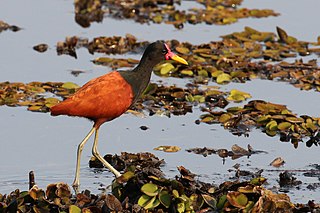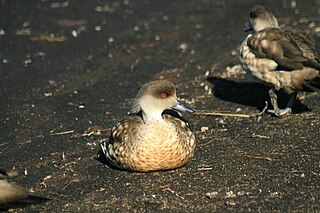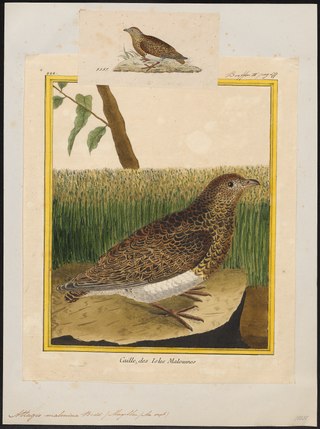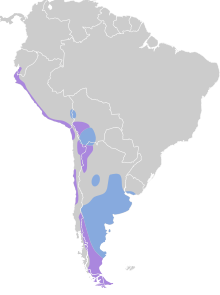
Charadriiformes is a diverse order of small to medium-large birds. It includes about 390 species and has members in all parts of the world. Most charadriiform birds live near water and eat invertebrates or other small animals; however, some are pelagic (seabirds), others frequent deserts, and a few are found in dense forest. Members of this group can also collectively be referred to as shorebirds.

Waders or shorebirds are birds of the order Charadriiformes commonly found wading along shorelines and mudflats in order to forage for food crawling or burrowing in the mud and sand, usually small arthropods such as aquatic insects or crustaceans. The term "wader" is used in Europe, while "shorebird" is used in North America, where "wader" may be used instead to refer to long-legged wading birds such as storks and herons.

The seedsnipes are a small family, Thinocoridae, of small gregarious waders which have adapted to a herbivorous diet. The family is divided into two genera, Attagis and Thinocorus, each containing two species. The family has a South American distribution, in the Andean and Patagonian regions. The relationships with other families within the order Charadriiformes are uncertain; it has been suggested that the plains wanderer of Australia, the jacanas and the painted snipes are their closest relatives. The plains wanderer in particular has a similar feeding ecology, although differs markedly in breeding biology. The family's common name is misleading, as they do not resemble true snipe, having short bills on small heads, and seeds do not form a major part of the diet. One species Thinocorus rumicivorus is however known to feed on the fleshy flower petal appendages of Calceolaria uniflora, a species of Scrophularaceae. In the process of feeding on these sugar rich appendages, they also pollinate the flowers.

The Andean condor is a giant South American Cathartid vulture and is the only member of the genus Vultur. Found in the Andes mountains and adjacent Pacific coasts of western South America, the Andean condor is the largest flying bird in the world by combined measurement of weight and wingspan. It has a maximum wingspan of 3.3 m and weight of 15 kg (33 lb). It is generally considered as the largest bird of prey in the world.

The rufous-bellied seedsnipe is a bird in suborder Scolopaci of order Charadriiformes, the shorebirds. It is found in Argentina, Bolivia, Chile, Ecuador, and Peru.

The wattled jacana is a wader which is a resident breeder from western Panama and Trinidad south through most of South America east of the Andes.

The crested duck or South American crested duck is a species of duck native to South America, the belonging to the monotypic genus Lophonetta. It is sometimes included in Anas, but it belongs to a South American clade that diverged early in dabbling duck evolution. There are two subspecies: L. specularioides alticola and L. specularioides specularioides. The Patagonian crested duck is also called the southern crested duck and its range lies in the Falklands, Chile, and Argentina.

The rufous-tailed hawk is a species of bird of prey in the family Accipitridae.

The pied plover, also known as the pied lapwing, is a species of bird in the family Charadriidae. It is a bird of least concern according to the IUCN and can be found in northern South America. The species name cayanus refers to Cayenne, the capital of French Guiana, where the pied plover can be found.

The Puna ibis is a species of bird in the family Threskiornithidae. It is found in Argentina, Bolivia, Chile, and Peru. Its natural habitats are swamps, marshes and lakes, and most of its range is in the Andean highlands, including the puna, but locally it occurs down to sea level. It has been domesticated by the Uru people for meat and eggs.

The chucao tapaculo is a species of bird in the family Rhinocryptidae. It is found in central Chile and adjacent Argentina; it has also been recorded in Chile's Magallanes Province.

The white-rumped swallow is a species of bird in the family Hirundinidae. First described and given its binomial name by French ornithologist Louis Vieillot in 1817, it was for many years considered a subspecies of the Chilean swallow. The species is monotypic with no known population variations. It has a white supraloral streak, or streak above its lores, which can be used to differentiate it from the Chilean swallow. The lores, ear coverts, tail, and wings are black, with white tips on the inner secondaries, tertials, and greater coverts of the wings. The rest of the upperparts are a glossy blue. Its underparts and underwing-coverts are white, in addition to the rump, as the name suggests. The sexes are similar, and the juvenile is duller and browner with a dusky breast.

The Chilean swallow is a species of bird in the family Hirundinidae. It breeds in Chile and Patagonia, migrating north as far as Bolivia, Paraguay, and Rio Grande do Sul.

The silvery grebe is a species of grebe in the family Podicipedidae. It is found in the western and southern part of South America at altitudes of up to 4,000 metres (13,000 ft). Its natural habitat is freshwater lakes but it also feeds in saline lakes.

The white-bellied seedsnipe is a species of bird in suborder Scolopaci of order Charadriiformes, the shorebirds. It is found Argentina and Chile.

The Peruvian thick-knee is a species of bird in the family Burhinidae. It is found in Chile, Ecuador, and Peru. Its natural habitats are subtropical or tropical dry shrubland, subtropical or tropical seasonally wet or flooded lowland grassland, and pastureland. It is a ground-dwelling bird and feeds on insects and small animals.

The grey-breasted seedsnipe is a species of bird in the family Thinocoridae. It is found in Argentina, Bolivia, Chile, and Peru.
Ana Lake is a Patagonian lake in the Pali-Aike National Park, San Gregorio, Magallanes Region, Chile.


















